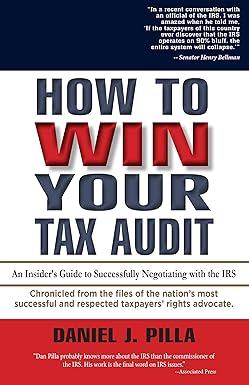Question
Assumption: the stock of X is owned equally by two shareholders Y (a corporation) and A (an individual). X uses the accrual method, A use
Assumption: the stock of X is owned equally by two shareholders Y (a corporation) and A (an individual). X uses the accrual method, A use the cash method, and all use a Calendar taxable year. (Assume section 1059 does not apply). Use a 34% corporate tax rate. During the current year, X accrued income and expenses as follows: Gross income from business $500 Dividends on AT&T stock 100 Interest on municipal bonds 100 Capital gain 100 Deductible business expenses $430 Noncapital expenses not deductible under 162(e) 90 Capital losses 146 What is Xs Taxable income-use 34% as the tax rate? Explain what is included and what is excluded and why. What is Xs E&P? Explain what is included and what is excluded and why. On December 24 of the preceding year, Y and A incorporate A and capitalize X with cash of $100 each. On December 31 of that preceding year, Y and A receive distributions from X of $5 dollars each. X did not earn any income for that year. In addition Y and A receive distributions of five dollars each, in the current year. Show your b(1);c (1),c(2),and c(3) chart. Which distribution should be gross income to why and I, in what amounts, and why? What does E&P have to do with this? As an alternative A just bought extra shares on December 30 of the current year from another shareholder for the fair market value of $145 before the declaration and payment of the five dollar distribution to A on December 31 of the current year. Should the distribution be taxable income to A? Why? Assume that Ys basis in Xs stock is $100 and As basis is $40. On January 2 of the current taxable year, X distributes $100 in cash to Y and $100 in cash to A. As of the end of the preceding taxable year, X's accumulated E&P was zero. What are the tax consequences of this distribution to X, Y, and A? Now assume that Ys basis in its X stock is $100 and As basis and his X stock is $40. On January 2 of the taxable year, X distributes $100 in cash to Y and $100 in cash to A. At the end of the preceding taxable year, Xs accumulated E&P was zero. Paragraph i What are the tax consequences of this distribution to X, Y, and A? ii How much dividend would Y and the holders of the As shares receive id As shares were owned by different shareholders every quarter and $50 was distributed ratably to the shareholders quarterly? F. Suppose under the basic facts in E above X had an accumulated deficit of $100 in its E&P account as of December 31 of the preceding taxable year?
Step by Step Solution
There are 3 Steps involved in it
Step: 1

Get Instant Access to Expert-Tailored Solutions
See step-by-step solutions with expert insights and AI powered tools for academic success
Step: 2

Step: 3

Ace Your Homework with AI
Get the answers you need in no time with our AI-driven, step-by-step assistance
Get Started


